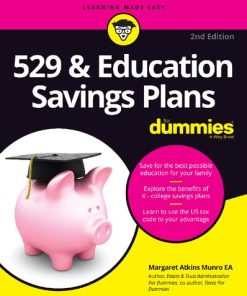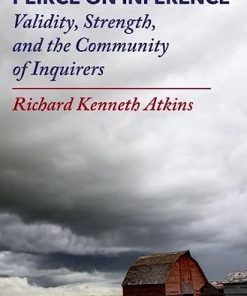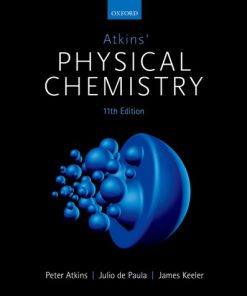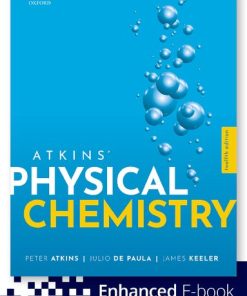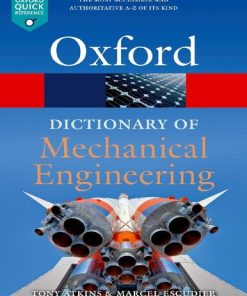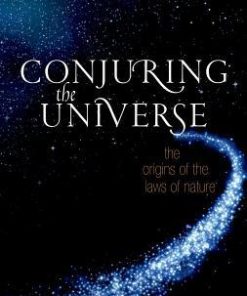(Ebook PDF) Atkins’ Physical Chemistry 12th Edition Peter Atkins, Julio de Paula, James Keeler 0198847815 978-0198847816 full chapters
$50.00 Original price was: $50.00.$25.00Current price is: $25.00.
Atkins’ Physical Chemistry 12th Edition by Peter Atkins, Julio de Paula, James Keeler – Ebook PDF Instant Download/DeliveryISBN: 0198847815, 978-0198847816
Full download Atkins’ Physical Chemistry 12th Edition after payment.
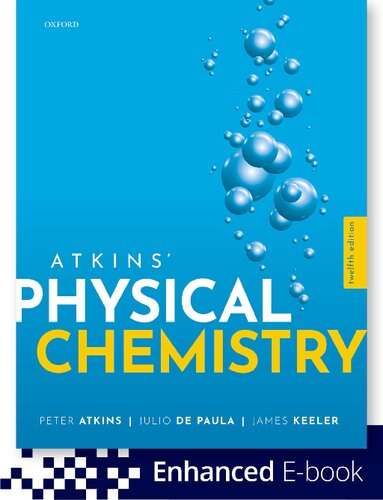
Product details:
ISBN-10 : 0198847815
ISBN-13 : 978-0198847816
Author: Peter Atkins, Julio de Paula, James Keeler
The exceptional quality of previous editions has been built upon to make the twelfth edition of Atkins’ Physical Chemistry even more closely suited to the needs of both lecturers and students. The writing style has been refreshed in collaboration with current students of physical chemistry in order to retain the clarity for which the book is recognised while mirroring the way you read and engage with information.
The new edition is now available as an enhanced e-book, which offers you a richer, more dynamic learning experience. It does this by incorporating digital enhancements that are carefully curated and thoughtfully inserted at meaningful points to enhance the learning experience. In addition, it offers formative auto-graded assessment materials to provide you with regular opportunities to test their understanding.
Atkins’ Physical Chemistry 12th Table of contents:
1 Force
(a) Linear momentum
(b) Angular momentum
(c) Newton’s second law of motion
2 Energy
(a) Work
(b) The definition of energy
3 Temperature
(a) The Boltzmann distribution
(b) The equipartition theorem
FOCUS 1 The properties of gases
TOPIC 1A The perfect gas
1A.1 Variables of state
1A.1(a) Pressure and volume
1A.1(b) Temperature
1A.1(c) Amount
1A.1(d) Intensive and extensive properties
1A.2 Equations of state
1A.2(a) The empirical basis of the perfect gas law
1A.2(b) The value of the gas constant
1A.2(c) Mixtures of gases
TOPIC 1B The kinetic model
1B.1 The model
1B.1(a) Pressure and molecular speeds
1B.1(b) The Maxwell–Boltzmann distribution of speeds
1B.1(c) Mean values
1B.2 Collisions
1B.2(a) The collision frequency
1B.2(b) The mean free path
TOPIC 1C Real gases
1C.1 Deviations from perfect behaviour
1C.1(a) The compression factor
1C.1(b) Virial coefficients
1C.1(c) Critical constants
1C.2 The van der Waals equation
1C.2(a) Formulation of the equation
1C.2(b) The features of the equation
1C.2(c) The principle of corresponding states
FOCUS 1 The properties of gases
TOPIC 1A The perfect gas
Discussion questions
Additional exercises
Problems
TOPIC 1B The kinetic model
Discussion questions
Additional exercises
Problems
TOPIC 1C Real gases
Discussion questions
Additional exercises
Problems
FOCUS 1 The properties of gases
Integrated activities
FOCUS 2 The First Law
TOPIC 2A Internal energy
2A.1 Work, heat, and energy
2A.1(a) Definitions
2A.1(b) The molecular interpretation of heat and work
2A.2 The definition of internal energy
2A.2(a) Molecular interpretation of internal energy
2A.2(b) The formulation of the First Law
2A.3 Expansion work
2A.3(a) The general expression for work
2A.3(b) Expansion against constant pressure
2A.3(c) Reversible expansion
2A.3(d) Isothermal reversible expansion of a perfect gas
2A.4 Heat transactions
2A.4(a) Calorimetry
2A.4(b) Heat capacity
TOPIC 2B Enthalpy
2B.1 The definition of enthalpy
2B.1(a) Enthalpy change and heat transfer
2B.1(b) Calorimetry
2B.2 The variation of enthalpy with temperature
2B.2(a) Heat capacity at constant pressure
2B.2(b) The relation between heat capacities
TOPIC 2C Thermochemistry
2C.1 Standard enthalpy changes
2C.1(a) Enthalpies of physical change
2C.1(b) Enthalpies of chemical change
2C.1(c) Hess’s law
2C.2 Standard enthalpies of formation
2C.3 The temperature dependence of reaction enthalpies
2C.4 Experimental techniques
2C.4(a) Differential scanning calorimetry
2C.4(b) Isothermal titration calorimetry
TOPIC 2D State functions and exact differentials
2D.1 Exact and inexact differentials
2D.2 Changes in internal energy
2D.2(a) General considerations
2D.2(b) Changes in internal energy at constant pressure
2D.3 Changes in enthalpy
2D.4 The Joule–Thomson effect
TOPIC 2E Adiabatic changes
2E.1 The change in temperature
2E.2 The change in pressure
FOCUS 2 The First Law
TOPIC 2A Internal energy
Discussion questions
Additional exercises
Problems
TOPIC 2B Enthalpy
Discussion questions
Additional Exercises
Problems
TOPIC 2C Thermochemistry
Discussion questions
Additional exercises
Problems
TOPIC 2D State functions and exact differentials
Discussion questions
Additional exercises
Problems
TOPIC 2E Adiabatic changes
Discussion questions
Additional exercises
Problems
FOCUS 2 The First Law
Integrated activities
FOCUS 3 The Second and Third Laws
TOPIC 3A Entropy
3A.1 The Second Law
3A.2 The definition of entropy
3A.2(a) The thermodynamic definition of entropy
3A.2(b) The statistical definition of entropy
3A.3 The entropy as a state function
3A.3(a) The Carnot cycle
3A.3(b) The thermodynamic temperature
3A.3(c) The Clausius inequality
TOPIC 3B Entropy changes accompanying specific processes
3B.1 Expansion
3B.2 Phase transitions
3B.3 Heating
3B.4 Composite processes
TOPIC 3C The measurement of entropy
3C.1 The calorimetric measurement of entropy
3C.2 The Third Law
3C.2(a) The Nernst heat theorem
3C.2(b) Third-Law entropies
3C.2(c) The temperature dependence of reaction entropy
TOPIC 3D Concentrating on the system
3D.1 The Helmholtz and Gibbs energies
3D.1(a) Criteria of spontaneity
3D.1(b) Some remarks on the Helmholtz energy
3D.1(c) Maximum work
3D.1(d) Some remarks on the Gibbs energy
3D.1(e) Maximum non-expansion work
3D.2 Standard molar Gibbs energies
3D.2(a) Gibbs energies of formation
3D.2(b) The Born equation
TOPIC 3E Combining the First and Second Laws
3E.1 Properties of the internal energy
3E.1(a) The Maxwell relations
3E.1(b) The variation of internal energy with volume
3E.2 Properties of the Gibbs energy
3E.2(a) General considerations
3E.2(b) The variation of the Gibbs energy with temperature
3E.2(c) The variation of the Gibbs energy of condensed phases with pressure
3E.2(d) The variation of the Gibbs energy of gases with pressure
FOCUS 3 The Second and Third Laws
TOPIC 3A Entropy
Discussion questions
Additional exercises
Problems
TOPIC 3B Entropy changes accompanying specific processes
Discussion question
Additional exercises
Problems
TOPIC 3C The measurement of entropy
Discussion question
Additional exercises
Problems
TOPIC 3D Concentrating on the system
Discussion questions
Additional exercises
Problems
TOPIC 3E Combining the First and Second Laws
Discussion questions
Additional exercises
Problems
FOCUS 3 The Second and Third Laws
Integrated activities
FOCUS 4 Physical transformations of pure substances
TOPIC 4A Phase diagrams of pure substances
4A.1 The stabilities of phases
4A.1(a) The number of phases
4A.1(b) Phase transitions
4A.1(c) Thermodynamic criteria of phase stability
4A.2 Coexistence curves
4A.2(a) Characteristic properties related to phase transitions
4A.2(b) The phase rule
Step 1 Consider the case where only one component is present
Step 2 Consider the general case of any number of components, C
4A.3 Three representative phase diagrams
4A.3(a) Carbon dioxide
4A.3(b) Water
4A.3(c) Helium
TOPIC 4B Thermodynamic aspects of phase transitions
4B.1 The dependence of stability on the conditions
4B.1(a) The temperature dependence of phase stability
4B.1(b) The response of melting to applied pressure
4B.1(c) The vapour pressure of a liquid subjected to pressure
4B.2 The location of coexistence curves
4B.2(a) The slopes of the coexistence curves
4B.2(b) The solid–liquid coexistence curve
4B.2(c) The liquid–vapour coexistence curve
4B.2(d) The solid–vapour coexistence curve
FOCUS 4 Physical transformations of pure substances
TOPIC 4A Phase diagrams of pure substances
Discussion questions
Additional exercises
Problems
TOPIC 4B Thermodynamic aspects of phase transitions
Discussion questions
Additional exercises
Problems
FOCUS 4 Physical transformations of pure substances
Integrated activities
FOCUS 5 Simple mixtures
TOPIC 5A The thermodynamic description of mixtures
5A.1 Partial molar quantities
5A.1(a) Partial molar volume
5A.1(b) Partial molar Gibbs energies
5A.1(c) The Gibbs–Duhem equation
5A.2 The thermodynamics of mixing
5A.2(a) The Gibbs energy of mixing of perfect gases
5A.2(b) Other thermodynamic mixing functions
5A.3 The chemical potentials of liquids
5A.3(a) Ideal solutions
5A.3(b) Ideal–dilute solutions
TOPIC 5B The properties of solutions
5B.1 Liquid mixtures
5B.1(a) Ideal solutions
5B.1(b) Excess functions and regular solutions
5B.2 Colligative properties
5B.2(a) The common features of colligative properties
5B.2(b) The elevation of boiling point
5B.2(c) The depression of freezing point
5B.2(d) Solubility
5B.2(e) Osmosis
TOPIC 5C Phase diagrams of binary systems: liquids
5C.1 Vapour pressure diagrams
5C.2 Temperature–composition diagrams
5C.2(a) The construction of the diagrams
5C.2(b) The interpretation of the diagrams
5C.3 Distillation
5C.3(a) Fractional distillation
5C.3(b) Azeotropes
5C.3(c) Immiscible liquids
5C.4 Liquid–liquid phase diagrams
5C.4(a) Phase separation
5C.4(b) Critical solution temperatures
5C.4(c) The distillation of partially miscible liquids
TOPIC 5D Phase diagrams of binary systems: solids
5D.1 Eutectics
5D.2 Reacting systems
5D.3 Incongruent melting
TOPIC 5E Phase diagrams of ternary systems
5E.1 Triangular phase diagrams
5E.2 Ternary systems
5E.2(a) Partially miscible liquids
5E.2(b) Ternary solids
TOPIC 5F Activities
5F.1 The solvent activity
5F.2 The solute activity
5F.2(a) Ideal–dilute solutions
5F.2(b) Real solutes
5F.2(c) Activities in terms of molalities
5F.3 The activities of regular solutions
5F.4 The activities of ions
5F.4(a) Mean activity coefficients
5F.4(b) The Debye–Hückel limiting law
5F.4(c) Extensions of the limiting law
FOCUS 5 Simple mixtures
TOPIC 5A The thermodynamic description of mixtures
Discussion questions
Additional exercises
Problems
TOPIC 5B The properties of solutions
Discussion questions
Additional exercises
Problems
TOPIC 5C Phase diagrams of binary systems: liquids
Discussion questions
Additional exercises
Problems
TOPIC 5D Phase diagrams of binary systems: solids
Discussion questions
Additional exercises
Problems
TOPIC 5E Phase diagrams of ternary systems
Discussion questions
Additional exercises
Problems
TOPIC 5F Activities
Discussion questions
Additional exercises
Problems
FOCUS 5 Simple mixtures
Integrated activities
FOCUS 6 Chemical equilibrium
TOPIC 6A The equilibrium constant
6A.1 The Gibbs energy minimum
6A.1(a) The reaction Gibbs energy
6A.1(b) Exergonic and endergonic reactions
6A.2 The description of equilibrium
6A.2(a) Perfect gas equilibria
6A.2(b) The general case of a reaction
6A.2(c) The relation between equilibrium constants
6A.2(d) Molecular interpretation of the equilibrium constant
TOPIC 6B The response of equilibria to the conditions
6B.1 The response to pressure
6B.2 The response to temperature
6B.2(a) The van ’t Hoff equation
6B.2(b) The value of K at different temperatures
TOPIC 6C Electrochemical cells
6C.1 Half-reactions and electrodes
6C.2 Varieties of cell
6C.2(a) Liquid junction potentials
6C.2(b) Notation
6C.3 The cell potential
6C.3(a) The Nernst equation
6C.3(b) Cells at equilibrium
6C.4 The determination of thermodynamic functions
TOPIC 6D Electrode potentials
6D.1 Standard potentials
6D.1(a) The measurement procedure
6D.1(b) Combining measured values
6D.2 Applications of standard electrode potentials
6D.2(a) The electrochemical series
6D.2(b) The determination of activity coefficients
6D.2(c) The determination of equilibrium constants
FOCUS 6 Chemical equilibrium
TOPIC 6A The equilibrium constant
Discussion questions
Additional exercises
Problems
TOPIC 6B The response of equilibria to the conditions
Discussion questions
Additional exercises
Problems
TOPIC 6C Electrochemical cells
Discussion questions
Additional exercises
Problems
TOPIC 6D Electrode potentials
Discussion questions
Additional exercises
Problems
FOCUS 6 Chemical equilibrium
Integrated activities
FOCUS 16 Molecules in motion
TOPIC 16A Transport properties of a perfect gas
16A.1 The phenomenological equations
16A.2 The transport parameters
16A.2(a) The diffusion coefficient
16A.2(b) Thermal conductivity
16A.2(c) Viscosity
16A.2(d) Effusion
TOPIC 16B Motion in liquids
16B.1 Experimental results
16B.1(a) Liquid viscosity
16B.1(b) Electrolyte solutions
16B.2 The mobilities of ions
16B.2(a) The drift speed
16B.2(b) Mobility and conductivity
16B.2(c) The Einstein relations
TOPIC 16C Diffusion
16C.1 The thermodynamic view
16C.2 The diffusion equation
16C.2(a) Simple diffusion
16C.2(b) Diffusion with convection
16C.2(c) Solutions of the diffusion equation
16C.3 The statistical view
FOCUS 16 Molecules in motion
TOPIC 16A Transport properties of a perfect gas
Discussion questions
Additional exercises
Problems
TOPIC 16B Motion in liquids
Discussion questions
Additional exercises
Problems
TOPIC 16C Diffusion
Discussion questions
Additional exercises
Problems
FOCUS 16 Molecules in motion
Integrated activities
FOCUS 17 Chemical kinetics
TOPIC 17A The rates of chemical reactions
17A.1 Monitoring the progress of a reaction
17A.1(a) General considerations
17A.1(b) Special techniques
17A.2 The rates of reactions
17A.2(a) The definition of rate
17A.2(b) Rate laws and rate constants
17A.2(c) Reaction order
17A.2(d) The determination of the rate law
TOPIC 17B Integrated rate laws
17B.1 Zeroth-order reactions
17B.2 First-order reactions
17B.3 Second-order reactions
TOPIC 17C Reactions approaching equilibrium
17C.1 First-order reactions approaching equilibrium
17C.2 Relaxation methods
TOPIC 17D The Arrhenius equation
17D.1 The temperature dependence of rate constants
17D.2 The interpretation of the Arrhenius parameters
17D.2(a) A first look at the energy requirements of reactions
17D.2(b) The effect of a catalyst on the activation energy
TOPIC 17E Reaction mechanisms
17E.1 Elementary reactions
17E.2 Consecutive elementary reactions
17E.3 The steady-state approximation
17E.4 The rate-determining step
17E.5 Pre-equilibria
17E.6 Kinetic and thermodynamic control of reactions
TOPIC 17F Examples of reaction mechanisms
17F.1 Unimolecular reactions
17F.2 Polymerization kinetics
17F.2(a) Stepwise polymerization
17F.2(b) Chain polymerization
17F.3 Enzyme-catalysed reactions
TOPIC 17G Photochemistry
17G.1 Photochemical processes
17G.2 The primary quantum yield
17G.3 Mechanism of decay of excited singlet states
17G.4 Quenching
17G.5 Resonance energy transfer
FOCUS 17 Chemical kinetics
TOPIC 17A The rates of chemical reactions
Discussion questions
Additional exercises
Problems
TOPIC 17B Integrated rate laws
Discussion questions
Additional exercises
Problems
TOPIC 17C Reactions approaching equilibrium
Discussion questions
Additional exercises
Problems
TOPIC 17D The Arrhenius equation
Discussion questions
Additional exercises
Problems
TOPIC 17E Reaction mechanisms
Discussion questions
Additional exercises
Problems
TOPIC 17F Examples of reaction mechanisms
Discussion questions
Additional exercises
Problems
TOPIC 17G Photochemistry
Discussion question
Additional exercises
Problems
FOCUS 17 Chemical kinetics
Integrated activities
People also search for Atkins’ Physical Chemistry 12th:
atkins physical chemistry 10e
atkins physical chemistry 12th edition
atkins physical chemistry oup
atkins physical chemistry solutions
atkins physical chemistry 11th edition
Tags:
Atkins,Physical Chemistry,Peter Atkins,Julio de Paula,James Keeler
You may also like…
Business & Economics - Personal Finance
Fiction - Contemporary Fiction
Chemistry - Physical Chemistry
Reference - Thesauri
Fiction - Literary Fiction




